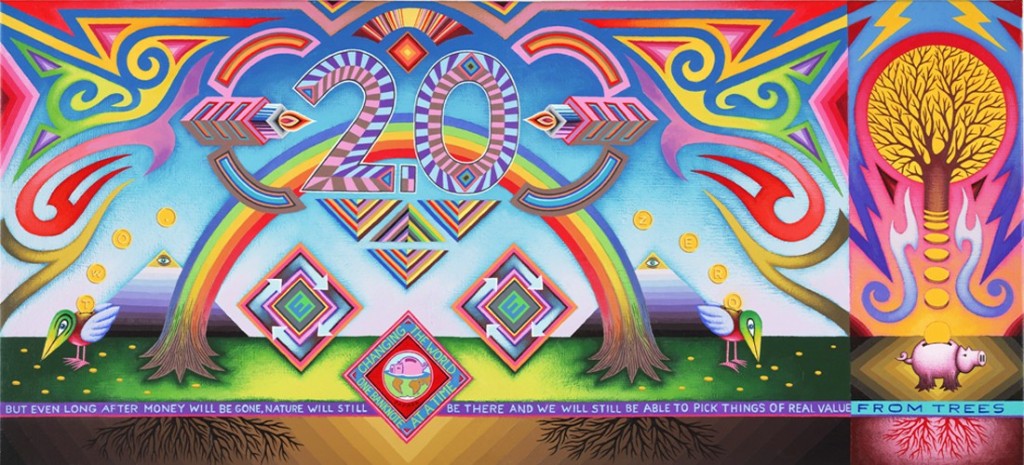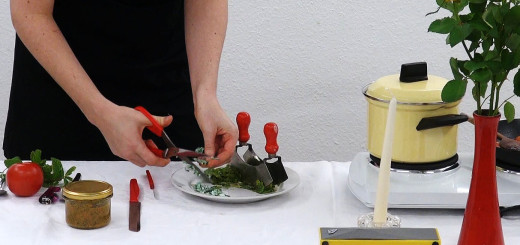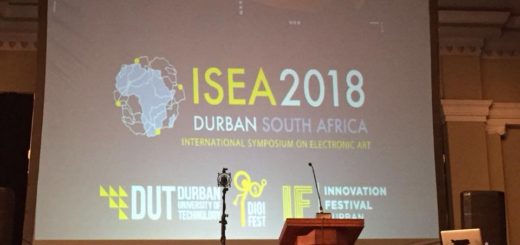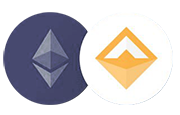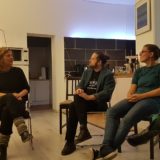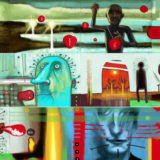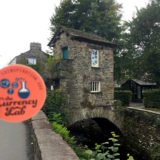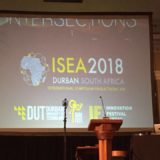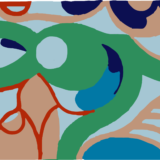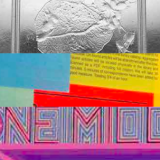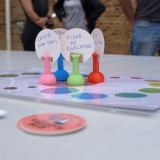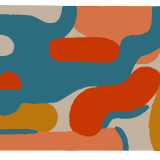Artists as Bankers, Currency as Art
Alternative currencies can be developed as emergency responses to an economic crisis and lack of enough “official” currency, or as proactive initiatives to foster local and underserved economies, but can also be created as works of art, to provoke thought about the subject and bring beauty to money, which is normally seen as merely practical or even dirty.
Devin Balkind, a nonprofit technologist at Sarapis.org, proposes that museums should issue their own currency, backed by their invaluable collections of artworks. He says museums are one of the wealthiest civic institutions in any city, often in stark contrast to the poverty of its citizens, and they should be granted the same privilege as a bank to issue loans and engage in fractional-reserve banking.
While this hasn’t happened yet, some artists have already created banks and issue their own currencies. One of them is the Art Reserve Bank, based in the Netherlands, a country with a long tradition of markets and exchange.
Created by Ron Peperkamp in 2012, the Art Reserve bank has a mint and issues coins which are in themselves a work of art. The coins are quite large, enough to provide a sizable canvas. Commissioned artists create designs that are minted on unique one-hundred coin editions roughly every week and can be bought by the general public.
Besides investing in a work of art, anybody that buys a coin also becomes a member of the cooperative bank and can vote and discuss its financial and artistic future plans at the yearly board meetings. In addition, the coins are a monetary investment, and earn a yearly return of 10 percent. The bank invests the funds from coin sales in the art project itself, but keeps a reserve in its vault to pay the dividends to the members who choose to return their coins and cash in their investment.
There is of course always a risk of a “bank run”, in which case the experiment will end. It’s unlikely that the Dutch government will be willing to bail the bank out with public funds. Luckily, according to Peperkamp, the great majority of coin owners are quite happy with holding on to their works of art, and very few so far have exchanged the coins back for the money. In any case, the reserves the art bank keeps are greater than what “normal” banks do these days, plus the electronic money issued by the latter has no intrinsic artistic value.
The Art Reserve Bank provides the following disclaimer for coin buyers:
“The coin is not legal tender so it cannot be used to pay your taxes. Officially it cannot be used to pay for anything. Also the coin does not work as a voucher for cultural activities or to purchase art or something. In fact you cannot do anything with it.
But with the coin, you obviously have something in possession that you may enjoy: as a unique work of art, as an interesting story, as proof of participation in a remarkable experiment or just as a visually attractive investment.
But more importantly the coin has a stable value and can literally serve as a reserve currency in case things go wrong with the euro or the dollar or any currency whatsoever within the current monetary system. Furthermore, as a possessor of the coin, you are also co-owner of the bank and you can take part in setting the artistic and financial course of the project.
If all that is not enough, you can always return your coin and change it back to euros.”
For those who are interested, the coins can be purchased online at www.kunstreservebank.nl or at one of their branches. For now there are branches in the Netherlands, Germany, Sweden and Austria, but in fact any member can choose to open a local branch, and is provided upon request with a kit including all materials needed.
Money Tree
Another artist from the Netherlands also created his own bank, but issues beautiful paper notes instead of coins. Dadara is the artist behind the Exchangibition Bank art project. The bank has an itinerant exchange booth where people can change euros or dollars for the bank’s special currency. The designs are all painted by hand by Dadara himself, and then reproduced on the paper notes, which come in unique denominations, like infinite, or zero. There is also a note with the value of “love”, and one worth “one like”, this one inspired by social media and its view of popularity as a currency.
The project goes further and invites people to take their euros, dollars or other national currencies and transform the notes into art by adding drawings and other enhancements, then hang them on a “Transformoney Tree” they exhibit at different venues, including the Burning Man Festival, a money-free experimental temporary community in the Nevada desert.
According to the imprint on the note with value of 2.0 (a reference to software version jargon):
“even long after money will be gone, nature will still be there and we will still be able to pick things of real value from trees.”
Dadara’s projects (including his new “Hourtopia – One Hour of Infinity” about time, money and art) can be found at www.artasmoney.com
Time is Money
A third example of art bank is the Time/Bank, a project by Julieta Aranda and Anton Vidokle. Despite having issued some very beautiful paper notes, most of its currency is in electronic form, and the transactions are done online using an open source software. The project started as a way of artists to exchange time and skills between themselves, and evolved to an art project in itself, having being exhibited at different venues like the Kassel Documenta and the Creative Accounting exhibition at UTS Gallery in Sydney.
In a time bank, money is created by mutual credit between the participants. Anybody can open an account, offer services in exchange for time/bank “hours”, or buy a service they need with their credit of time/bank hours. In this case, their account will show a negative value (all accounts start with zero balance) but that’s not reason for panic, because it does not mean any interest owned, fees or other punishment.
The artists state that “through Time/Bank, we hope to create an immaterial currency and a parallel micro-economy for the cultural community, one that is not geographically bound, and that will create a sense of worth for many of the exchanges that already take place within our field – particularly those that do not produce commodities and often escape the structures that validate only certain forms of exchange as significant or profitable.”
Some of the skills currently on offer are: music composition, general helpfulness, pet walking, listening and reflecting, cake baking. If you want to learn more, the project can be found at www.e-flux.com/timebank/
Originally published at MCD Magazine’s special Money Issue



